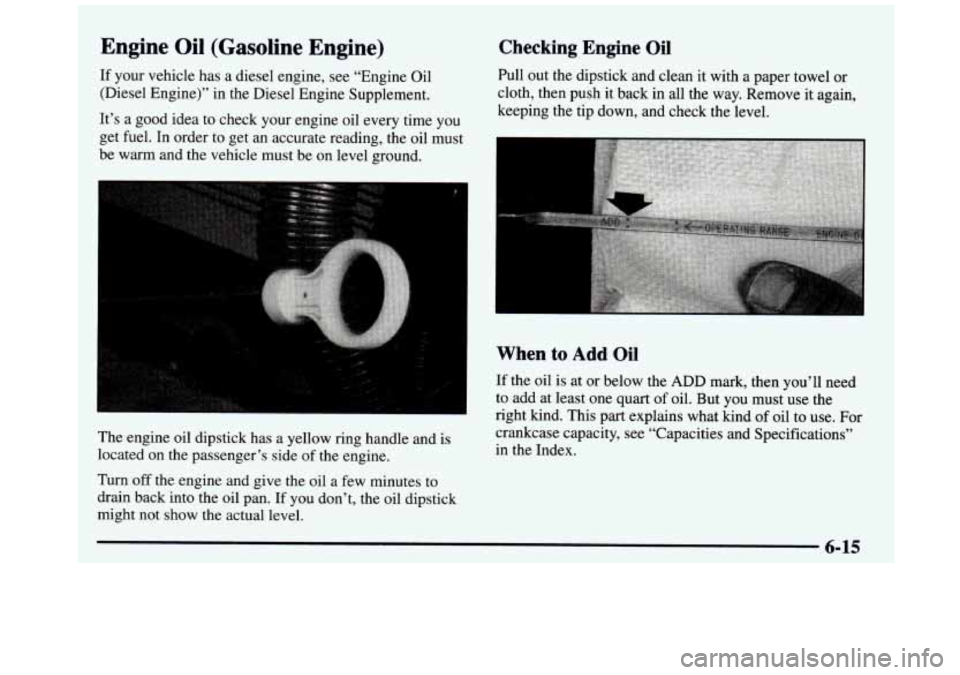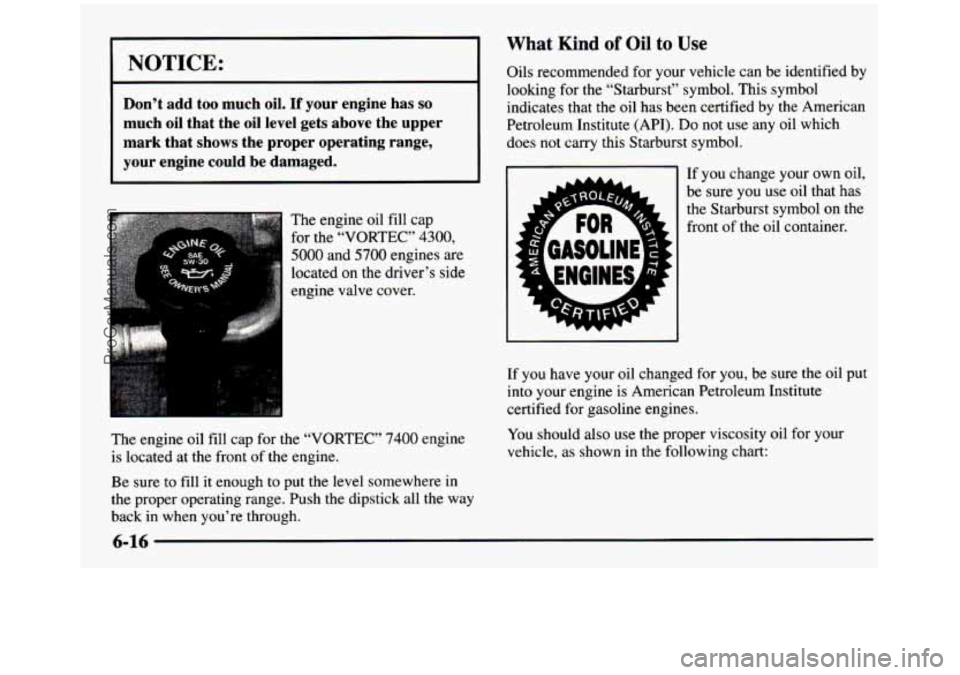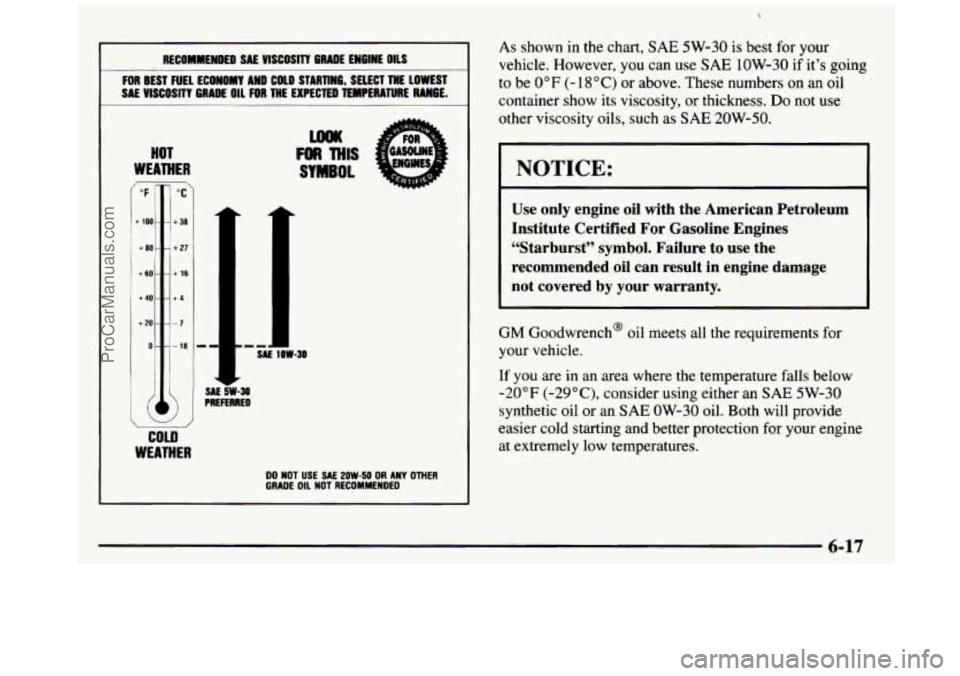Page 284 of 436
Checking Things Under the Hood
I A CAUTION:
If your vehicle has air conditioning, the auxiliary
engine fan under the hood can
start up and
injure you even when the engine
is not running.
Keep hands, clothing and tools away from any
underhood electric
fan.
t -4
Things that burn can get on hot engine parts and
start a fire. These include liquids like gasoline or
diesel fuel, oil, coolant, brake fluid, windshield
washer and other fluids, and plastic or rubber. You or others could be burned. Be careful
not to drop or spill things that will burn onto
a hot engine.
ProCarManuals.com
Page 286 of 436
“VORTEC” 4300,5000,5700 Engine
When you lift up the hood you’ll see:
“VORTEC” 5700 engine shown, locations for other engines similar.
6-10
ProCarManuals.com
Page 287 of 436
A. Battery
B. Air Cleaner
C. Radiator Cap
D. Coolant Recovery Tank
E. Air Filter Restriction Indicator
F. Engine Oil Dipstick
G. Automatic Transmission Dipstick
H. Fan
I. Power Steering Fluid Reservoir
J. Engine Oil Fill
K. Brake Fluid Reservoir
L. Windshield Washer Fluid Reservoir
M. Fuse/Relay Center
6-11
ProCarManuals.com
Page 289 of 436
A. Battery
B. Coolant Recovery Tank
C. Air Cleaner
D. Radiator Cap
E. Air Filter Restriction Indicator
E Engine Oil Dipstick
G. Automatic Transmission Dipstick
H. Engine Oil Fill
I. Fan
J. Power Steering Fluid Reservoir
K. Brake Fluid Reservoir
L. Windshield Washer Fluid Reservoir
M. FuseRelay Center
6-13
ProCarManuals.com
Page 290 of 436

Noise Control System
The following information relates to compliance with Federal noise emission standards
for vehicles with a Gross
Vehicle Weight Rating (GVWR) of more than
10,OOO lbs.
(4 536 kg). The Maintenance Schedule provides
information
on maintaining the noise control system to
minimize degradation of the noise emission control system
during the life of your vehicle. The noise control system
warranty is given in your Warranty booklet.
These standards apply only to vehicles sold
in the
United States.
Tampering With Noise Control
System Prohibited
Federal law prohibits the following acts or the
causing thereof:
I. The removal or rendering inoperative by any person,
other than for purposes of maintenance, repair or
replacement,
of any device or element of design
incorporated into any new vehicle for
the purpose
of noise control, prior to its sale or delivery
to the
ultimate purchaser or while it is in use; or
2. The use of the vehicle after such device or element
of design has
been removed or rendered inoperative
by any person. Among those
acts presumed
to constitute tampering are
the acts listed below.
Insulation:
0 Removal of the noise shields or underhood insulation.
Engine:
0 Removal or rendering engine speed governor (if
equipped) inoperative
so as to allow engine speed to
exceed manufacturer specifications.
Fan and Drive:
0 Removal of fan clutch (if equipped) or rendering
clutch inoperative.
0 Removal of the fan shroud (if equipped).
Air Intake:
Removal of the air cleaner silencer.
0 Reversing the air cleaner cover.
Exhaust:
0 Removal of the muffler and/or resonator.
Removal of the exhaust pipes and exhaust pipe clamps.
ProCarManuals.com
Page 291 of 436

Engine Oil (Gasoline Engine)
If your vehicle has a diesel engine, see “Engine Oil (Diesel Engine)” in the Diesel Engine Supplement.
It’s a good idea to check your engine oil every time you
get fuel. In order to get an accurate reading, the oil must
be warm and the vehicle must be on level ground.
The engine oil dipstick has
a yellow ring handle and is
located on the passenger’s side
of the engine.
Turn
off the engine and give the oil a few minutes to
drain back into the oil pan.
If you don’t, the oil dipstick
might not show the actual level.
Checking Engine Oil
Pull out the dipstick and clean it with a paper towel or
cloth, then push it back in all the way. Remove it again,
keeping the tip down, and check the level.
When to Add Oil
If the oil is at or below the ADD mark, then you’ll need
to add at least one
quart of oil. But you must use the
right kind. This part explains what kind of oil to use.
For
crankcase capacity, see “Capacities and Specifications”
in the Index.
6-15
ProCarManuals.com
Page 292 of 436

I 1 What Kind of Oil to Use
I NOTICE: I Oils recommended for your vehicle can be identified by
looking
for the “Starbuk” symbol. This symbol
.I
Don’t add too much oil. If your engine has so indicates that the oil has been certified by the American
much oil that the oil level gets above the upper Petroleum Institute (API). Do not use any oil which
mark that shows the proper operating range, does not carry this Starburst symbol.
The engine oil fill cap
for the “VORTEC”
4300,
5000 and 5700 engines are
located on the driver’s side
engine valve cover.
your engine could be damaged.
I
The engine oil fill cap for the “VORTEC” 7400 engine
is located at the front of the engine.
Be sure to fill it enough to put the level somewhere
in
the proper operating range. Push the dipstick all the way
back
in when you’re through. If you
change your own oil,
be sure
you use oil that has
the Starburst symbol on
the
front of the oil container.
If you have your oil changed for you, be sure the oil put
into your engine
is American Petroleum Institute
certified for gasoline engines.
You should also use the proper viscosity oil for your
vehicle, as shown
in the following chart:
ProCarManuals.com
Page 293 of 436

RECOMMENDED SAE YlSCOSlTT GRADE ENGINE OILS I
FOR BEST FUEL ECONOMY AND COLD STARTING, SELECT THE LOWEST
SAL VISCOSITY GRADE OIL
FOR THE EXPECTED TEMPERATURE RANGE. I
HOT
WEATHER
COLD
WEATHER
SAE 5w-30 PREFERRED
LWK
Fm THIS
SYMBOL
DO NOT USE SAE 2ow-50 OR ANY OTHER GRADE OIL NOT RECOMMENDED
As shown in the chart, SAE 5W-30 is best for your
vehicle. However, you can use
SAE 1OW-30 if it’s going
to be
0°F (- 18°C) or above. These numbers on an oil
container
show its viscosity, or thickness. Do not use
other viscosity oils, such
as SAE 20W-50.
NOTICE:
Use only engine oil with the American Petroleum
Institute Certified For Gasoline Engines
“Starburst” symbol. Failure to use the
recommended oil can result in engine damage
not covered by your warranty.
GM Goodwrench@ oil meets all the requirements for
your vehicle.
If you are in an area where the temperature falls below
-20°F (-29”C), consider using either an SAE 5W-30
synthetic oil or an SAE OW-30 oil. Both will provide
easier cold starting and better protection for your engine
at extremely low temperatures.
6-17
ProCarManuals.com